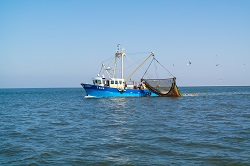Assessing trawling impact to better protect seabeds
Analysis, carried out through the EU-funded BENTHIS project, has shown that the damage caused by trawling is directly related to the penetration depth of equipment. The findings will help inform the fishing industry about its potential impact, the habitats most affected and fishing gear that cause the most damage. Using this assessment framework means that environmental impact can be predicted without the need for trial tests. This methodology is now available for use by relevant authorities. Project findings on the impact of trawling will also now inform the development of EU Marine Strategy Framework Directive (MSFD) indicators on sea floor integrity. ‘This means that we have the chance to further develop these methods and improve them,’ says BENTHIS project coordinator Professor Adriaan Rijnsdorp from Wageningen Marine Research in the Netherlands. ‘Ultimately, this project will help contribute towards the profitable exploitation of the sea at minimal ecological cost.’ Life on the seafloor The seafloor provides a habitat for an enormous diversity of life, in particular invertebrate species. These incredible organisms can alter the seafloor, for instance by building coral-like structures, or digging into the sediment. ‘This community of organisms found on or in the sea bed, known as benthos, also plays an important role in the transport of carbon from the water into the sediment, and for the release of nutrients into the water column,’ explains Professor Rijnsdorp. ‘Benthic invertebrates are also an important food source for many of our commercially exploited fish, shellfish and crustaceans.’ However, benthic ecosystems are increasingly affected by human activities such as fishing, sand and gravel extraction, oil and gas exploitation, shipping and pollution. Fishing, in particular bottom trawling, occurs in many parts of the sea floor of the continental shelves. ‘There is growing concern about the detrimental effects of bottom trawling, with some groups even calling for the practice to be stopped altogether,’ says Professor Rijnsdorp. ‘We therefore saw a need for robust science to determine exactly how serious this problem is; which areas we should be concerned about; and which fishing gear is causing damage.’ Mapping impact of trawling The BENTHIS project therefore set out to map the pressure of bottom trawling in European seas, and to quantify the environmental impact. The pressure of trawling was assessed by using high resolution data from various fishing fleets. The impact was estimated by conducting meta-analyses of existing peer-reviewed literature and integrating previous project results. ‘We also collaborated with industry in order to develop gear innovations that might mitigate trawling impact,’ explains Professor Rijnsdorp. ‘This has been very fruitful. Trawlers in the Mediterranean for example applied technical innovations to reduce the impact of digging, which also has fuel saving potential.’ The BENTHIS project’s assessment framework on the impact of trawling can be applied across European seas. In addition to demonstrating that benthic mortality rates are directly related to the penetration depth of fishing gear, the project also identified regions of the seabed most at risk. ‘We found that habitat sensitivity can be estimated from the longevity distribution of the benthic community,’ explains Professor Rijnsdorp. ‘Meta-analyses revealed that the recovery rate of a species is related to its longevity. This means that communities of long-lived species are more sensitive to trawling because of their slow recovery compared to short-lived communities.’
Keywords
BENTHIS, fishing, trawler, benthic, habitat, Mediterranean, marine, pollution



